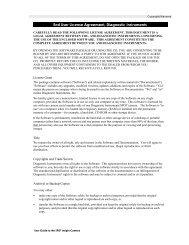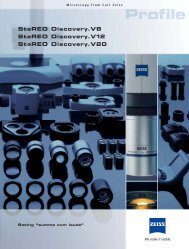optical interference filters - SPOT Imaging Solutions
optical interference filters - SPOT Imaging Solutions
optical interference filters - SPOT Imaging Solutions
Create successful ePaper yourself
Turn your PDF publications into a flip-book with our unique Google optimized e-Paper software.
Figure 4 Multi-layer broadband anti-reflective (BBAR) coatings can achieve<br />
reflections below 1% at a broad range of wavelengths, but at the<br />
expense of higher out-of-band reflectance and large percentage<br />
gains in reflectance at non-normal angles of incidence.<br />
Materials<br />
Anti-reflection in the visible and near-IR wavelengths can be achieved<br />
with a variety of different deposited compounds. Silicon monoxide,<br />
yttrium fluoride, and magnesium fluoride are three popular<br />
low-index-of-refraction materials. Silicon monoxide is used primarily<br />
in the infrared wavelengths, while yttrium fluoride and magnesium<br />
fluoride are used most frequently in the visible region. The<br />
primary drawback of these compounds is their durability. While<br />
anti-reflective coatings utilizing either of these can be cleaned,<br />
care must be taken not to cause damage. Anti-reflective coatings<br />
also can be made using harder oxide compounds that are more<br />
durable, but they tend not to perform quite as well and require that<br />
the optic be subjected to high temperatures during deposition. In<br />
general, the more energetic (higher temperature) the process that<br />
is used to deposit the anti-reflective coating, the more durable the<br />
resultant coating is.<br />
Moth-Eye and Random<br />
Microstructured Anti-Reflection<br />
The physical structure of moths’ eyes gives these insects a unique<br />
means of minimizing reflection. Reduced reflections off of moths’<br />
eyes can make the difference between their being eaten by a<br />
predator or remaining unseen. As a result of this environmental<br />
pressure, moths have evolved a regular repeating pattern of 3-D<br />
prominences on the surface of their eyes that effectively reduce<br />
reflection. With some effort, scientists have been able to duplicate<br />
the “moth-eye” pattern on glass to achieve a similar anti-reflection<br />
effect.<br />
Initially, it seems non-intuitive that simply changing the surface<br />
structure of the glass should reduce reflections off that surface. By<br />
changing the initially smooth, flat surface of the glass to a surface<br />
that has a regular pattern of prominences that are hundreds of<br />
nanometers in size, the surface area has actually increased dramatically.<br />
Increased surface area would seem to suggest higher<br />
reflection rather than lower.<br />
The reason for the reduced reflection off of a moth-eye surface is<br />
that the light no longer has a distinct boundary between the air and<br />
glass (or air and eye of the moth). Where there once was a very<br />
sharp boundary between air and glass, the transition now occurs<br />
over an appreciable fraction of a wavelength. Because reflections<br />
only can occur where there is a change in index of refraction and<br />
there is no longer a sharp boundary between materials, reflections<br />
are drastically reduced. In the visible range on fused silica, motheye<br />
anti-reflection treatment can achieve broadband reflection off<br />
each surface of 0.2% or better.<br />
It is important to note that the size of the microstructures is very important.<br />
The structure on moths’ eyes is a regular repeating pattern<br />
of hexagonal finger-like projections that are spaced roughly 300<br />
nm from each other and rise about 200 nm from the eye’s surface.<br />
This size of microstructure is optimized roughly for anti-reflection<br />
of the visible spectrum. If the structures are made slightly smaller<br />
or larger in size, the surface can be optimized to reflect shorter or<br />
longer wavelengths, respectively.<br />
For example, arsenic triselenide is used in optics in the 5- to<br />
15-micron range. A typical moth-eye structure for this window of<br />
wavelengths might have prominences that rise 3,500 nm from the<br />
substrate surface with an average spacing between prominences<br />
of about 2,400 nm. 3 Moth-eye structures of approximately this size<br />
can be seen in figure 5. Typical transmission improvement of the<br />
optic can be as much as 12% to 14% by treating just one side of<br />
the optic (figure 6).<br />
One major advantage of microstructured antireflective glass is its<br />
ability to withstand high incident energies of nearly 60 J/cm. 4<br />
Figure 5 <br />
SEM image<br />
of zinc selenide<br />
motheye<br />
microstructures.<br />
(Courtesy of<br />
TelAztec, Inc.)<br />
For current product listings, specifications, and pricing:<br />
www.omega<strong>filters</strong>.com • sales@omega<strong>filters</strong>.com<br />
1.866.488.1064 (toll free within USA only) • +1.802.254.2690 (outside USA)<br />
31

















